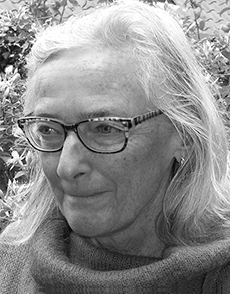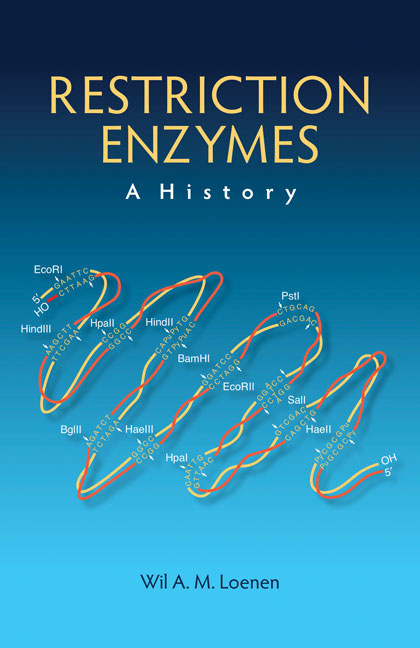Restriction Enzymes: A History
By Wil A.M. Loenen, Leiden University Medical Center
April 2019 · 346 pages, illustrated (38 color and 26 B&W)
ISBN 978-1-621821-05-2
<< References
About the Author

Reading Biology and Chemistry (BSc) and Molecular Genetics (MSc) at the University of Leiden led Wil A.M. Loenen to a lifelong passion for DNA. Aided by British Council Scholarships and an EEC grant, she obtained a PhD in the Faculty of Science at the University of Leicester. Under supervision of Bill Brammar, she made a widely used cloning vector (SCI 389), lambda L47.1, and cloned PstI. After various postdocs working with microorganisms and bacterial viruses in the United States, United Kingdom, and The Netherlands, including an important period with Noreen Murray at the University of Edinburgh, Loenen switched to immunology at the Netherlands Cancer Institute. Among others she was involved in the cloning and analysis of the human CD27 cDNA, cloned the human CD27 gene, and murine CD27. This led to a model on the role of CD27 in lymphomagenesis in a second PhD in the Faculty of Medicine at Leiden University Medical Center (with Kees Melief and Bob Lowenberg as advisors), a guest-editorship of Seminars in Immunology, and contributions to the online cytokine database of Academic Press. For a while she worked with Cathrien Bruggeman at Maastricht University and wrote a review on cytomegalovirus.
The seeds for this book were planted in Edinburgh at the farewell party ending the long professorship of Noreen Murray. With Murray's and David Dryden's help, Loenen wrote her first historical perspective on restriction enzymes, in this case celebrating 50 years of EcoKI, the E. coli K12 enzyme. This led to further reviews on restriction enzymes, as well as the role of S-adenosylmethionine (SAM). SAM proves to be not only an essential cofactor for EcoKI and relatives, but also an ancient, highly versatile cofactor to a myriad of other compounds, with a pivotal role in health, disease, and aging. Leiden University Medical Center has hosted Loenen for many years, allowing her access to e-mail and library facilities while working from home in nearby Leiderdorp. She is active in Women's Science Networks, keeping up with long-term friends around the world, enjoys reading, BBB (bee-, bird-, and butterfly-friendly) gardening, and last, but not least, beach walking with dog Sam.
Selected Publications
Restriction
Loenen WAM, Brammar WJB. 1980. A bacteriophage lambda vector for cloning large DNA fragments made with several restriction enzymes. Gene 10: 249–259. 10.1016/0378-1119(80)90054-2
Loenen WAM, Murray NE. 1986. Modification enhancement by the restriction alleviation protein (Ral) of bacteriophage lambda. J Mol Biol 190: 11–22. 10.1016/0022-2836(86)90071-9
Loenen WAM, Daniel AS, Braymer HD, Murray NE. 1987. Organization and sequence of the hsd genes of Escherichia coli K-12. J Mol Biol 198: 159–170. 10.1016/0022-2836(87)90303-2
Loenen WAM. 2003. Tracking EcoKI and DNA fifty years on: a golden story full of surprises. Nucleic Acids Res 31: 7059–7069. 10.1093/nar/gkg944
Loenen WAM, Raleigh EA. 2014. The other face of restriction: modification-dependent enzymes. Nucleic Acids Res 42: 56–69. 10.1093/nar/gkt747
Loenen WAM, Dryden DTF, Raleigh EA, Wilson GG. 2014. Type I restriction enzymes and their relatives. Nucleic Acids Res 42: 20–44. 10.1093/nar/gkt847
Loenen WAM, Dryden DTF, Raleigh EA, Wilson GG, Murray NE. 2014. Highlights of the DNA cutters: a short history of the restriction enzymes. Nucleic Acids Res 42: 3–19. 10.1093/nar/gkt990
CD27
Camerini D, Walz G, Loenen WAM, Borst J, Seed B. 1991. The T cell activation antigen CD27 is a member of the nerve growth factor/tumor necrosis factor receptor gene family. J Immunol 147: 3165–3169.
Loenen WAM, Gravestein LA, Beumer S, Melief CJ, Hagemeijer A, Borst J. 1992. Genomic organization and chromosomal localization of the human CD27 gene. J Immunol 149: 3937–3943.
Gravestein LA, Blom B, Nolten LA, de Vries E, van der Horst G, Ossendorp F, Borst J, Loenen WAM. 1993. Cloning and expression of murine CD27: comparison with 4-1BB, another lymphocyte-specific member of the nerve growth factor receptor family. Eur J Immunol 23: 943–950. 10.1002/eji.1830230427
Loenen WAM. 1997. “Molecular analysis of CD27 to elucidate the role in lymphocyte development.” PhD thesis, Faculty of Medicine, RUL NL.
Loenen WAM. 1998. CD27 and (TNFR) relatives in the immune system: their role in health and disease. Sem Immunol 10: 417–422. Guest Editor. 10.1006/smim.1998.0159
Loenen WAM, Bruggeman CA, Wiertz EJ. 2001. Immune evasion by human cytomegalovirus: lessons in immunology and cell biology. Sem Immunol 13: 41–49. 10.1006/smim.2001.0294
SAM
Loenen WAM. 2006. S-adenosylmethionine: jack of all trades and master of everything? Biochem Soc Trans 34: 330–333. 10.1042/BST0340330
Loenen WAM. 2010. S-adenosylmethionine: simple agent of methylation and secret to aging and metabolism? In Epigenetics of aging (ed. Tollefsbol TO), pp. 107–131. Springer, Berlin.
Loenen WAM. 2017. S-adenosylmethionine: a promising avenue in anti-aging medicine? In Anti-aging drugs: from basic research to clinical practice (ed. Vaiserman AM), Chap. 18. Royal Society of Chemistry, London.
Loenen WAM. 2018. S-adenosylmethionine metabolism and aging. In Epigenetics of aging and longevity (ed. Moskalev A, Vaiserman A), pp. 59–93. Elsevier, New York.

